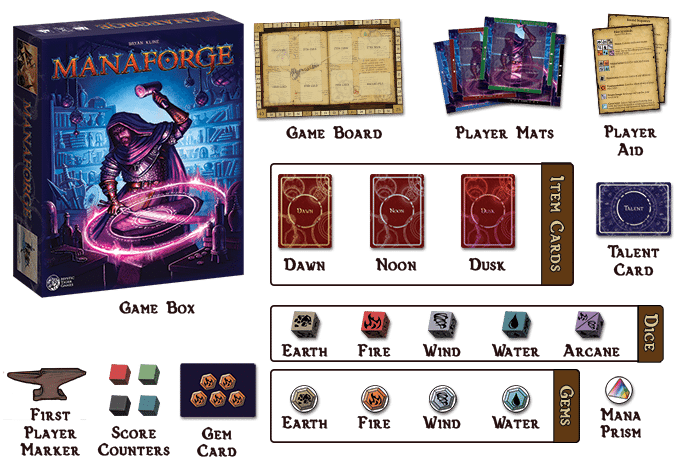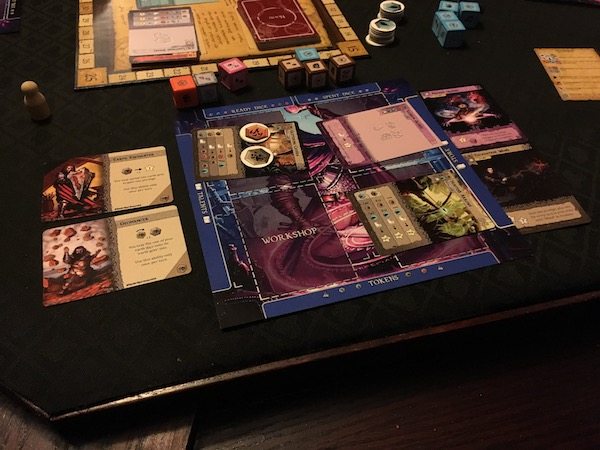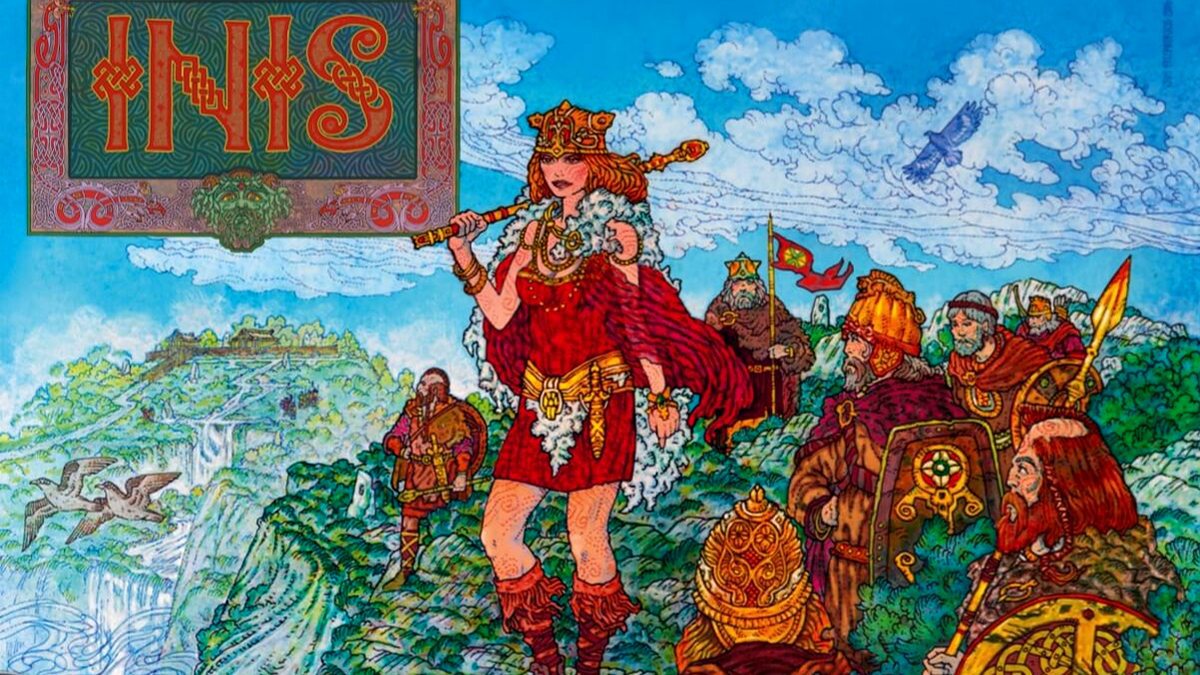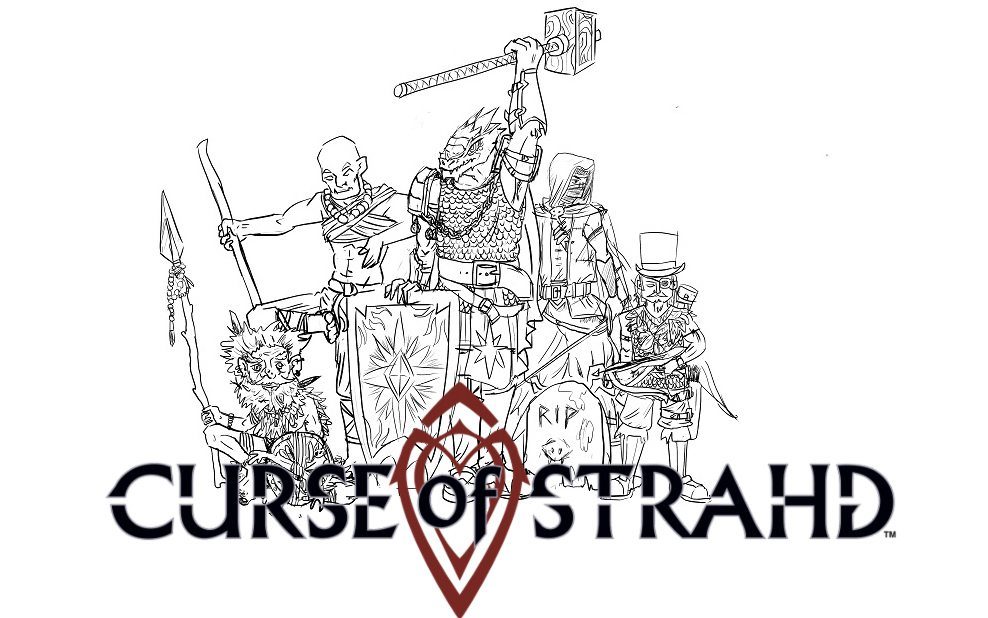
Have you ever wondered where all of those jaw-dropping magical items wizards use to do battle come from? Why, the Manaforge of course!
In this game, you take on the role of an arcane blacksmith and find out just how much goes on behind the scenes to outfit thrill seeking adventurers with the ability to call down incredible forces of nature on their foes. Do you have what it takes to make your shop stand out from all the rest and achieve wealth, power, and prestige throughout the land?
At a Glance: Manaforge is a dice rolling, resource management game for 2 to 4 players aged 13 and up. Games should take about an hour to play, though as with many games that rely heavily on card based textual mechanics, the first few times you play you’ll be doing a lot of reading and you can expect it to take as long as 90 minutes.
It’s currently seeking funding on Kickstarter, with a pledge of $40 for a copy of the base game. The rules are easy to pick up and there is a robust FAQ section in the rulebook that should cover any situational questions that come up during play.
New to Kickstarter? Check out our crowdfunding primer, and visit our curated page for more projects we love.
Components:

- 1 Game Board/Scoring Track
- 1 First Player Marker
- 4 Player Mats
- 4 Player Score Counters
- 4 Player Aid Cards
- 72 Item Cards (24 of each type)
- 20 Talent Cards
- 40 Mana Dice (8 of each type)
- 70 Gem/Prism Tokens
- 10 Multi-Gem/Prism Cards

Note: My review is based on a pre-production prototype, so cards and the component list may be subject to change in the final version and I can’t judge the final component quality. The artwork on many of the early round cards is complete, however, and I feel confident that you can get a good sense of the quality from these photographs.
How to Play:
Overview: Manaforge is played over 9 rounds. During each round, 6 cards are drawn from the magical item deck and placed face up on the game board. A round consists of each player rolling their dice to generate “mana,” which is the in-game currency for purchasing (forging!) items, and selecting an item from the game board to add to their workshop.
Mana comes in 5 elemental flavors: Earth, Fires, Wind, Water, and Arcane. Players pass a First Player Marker each round which sets the order of play and determines who has the first opportunity to purchase items from the main game board using their mana.
As the rounds progress, players may choose to upgrade the cards they already have in order to increase their power or to score victory points. Items become increasingly more expensive to purchase as the rounds pass and the game relies on the player’s ability to set up a system for generating more and more mana as the game progresses. The ultimate goal is to accumulate the most victory points, representing the prestige of your shop, by the end of 9 rounds.
In more detail: Setting up the game involves randomizing a few variables that ultimately make each game of Manaforge a unique puzzle. There are two sets of cards that control the flow of the game and will ultimately drive the player’s strategy.
- The Item Deck. This is the main draw pile that players use to stock the marketplace each round. This deck is split into three distinct types of cards: Dawn, Noon, and Dusk. These card types represent the passage of time in the game and serve as a reminder to the players of how many rounds remain. Each type contains a set of cards whose cost, complexity, and impact on the player’s victory point total increases as the game progresses. Dawn cards are the least expensive and primarily serve to help the player develop a strategy. Noon cards are more expensive to purchase but provide the player options for generating mana beyond simply what they can roll with their dice and begin giving the player opportunities to score victory points. Dusk cards are the real heavy hitters and allow the players to convert mana directly into victory points at a furious pace, provided they’ve set up their workshops wisely in the earlier rounds. The Item Deck is built during setup by selecting 18 shuffled cards from each category and stacking them together to form a single deck that plays from top to bottom through the phases of Dawn, Noon, and Dusk. There are 24 cards provided in the base game from each category so players can never be sure exactly what cards will be available during the game and must build a certain amount of flexibility into their strategies.

Image By: Mystic Tiger Games - The Talent Deck. This deck is used during the setup phase of the game to allow the players to craft a personality for their character. The talent cards are selected in a draft-like format so, in a way, the game between the players begins even before the first dice are rolled. Players are dealt 4 cards from the Talent deck. After reviewing the cards in their hand the player decides to keep 1 card and passes the remainder to the player on their left. This process repeats until each player has chosen four cards. Finally, the player selects 2 cards from their hand to use during the game. These cards are placed on the left of the player’s board and represent their special talents throughout the duration of the game. These cards allow the player to take extra dice, may provide extra mana on each turn, or may even grant the player a few free victory points at the beginning of the game. Most of these talents are aligned with a specific elemental flavor of mana; Earth mana based talents might give the player an extra Earth die and allow them to generate extra Earth mana during their turn based on their actions.

Image By: Mystic Tiger Games
Once the game is setup play is straightforward. Each player rolls their dice and chooses 4 of the results to play with that round. Each player starts with 4 dice, one of each elemental type, and may accumulate a larger number through the drafting of Talent Cards during game setup or through the purchase of Items from the Game Board during their turn. No matter how many dice a player rolls, however, only 4 can be chosen to fund their purchases during their turn each round.
During each turn players have as many as 5 actions they can take, in any order, in order to setup their workshop, accumulate mana, or score victory points. These 5 actions are listed in detail below.
- Use their dice. Players can choose to convert up to 4 of their dice into mana. There are some advantages in the later stages of the game to foregoing this action but early on this is the basic move every player makes. Roll dice and choose 4 to use as mana.
- Build an Item. Spend accumulated mana (mostly from rolled dice but there are cards that allow you to generate and store mana as the game develops) to purchase an item from the Game Board. There are two types of Items that can be purchased, Store cards which are instant effects and Workshop cards which are placed on the Player Mat and constitute the player’s workshop. If the player chooses not to build an item, they can instead take a token that essentially allows them to bank a free mana for use later in the game.
- Activate an Item. The player can choose a card from the workshop on the Player Mat and use its power. This is often done to gain extra mana during a turn.
- Upgrade an Item. The player can spend their mana to upgrade the items in the workshop. This generally allows them to provide more mana or victory points when they are activated.
- Activate a Talent. The Talent Cards that the player chose during the draft can often be used during a turn to gain mana or victory points depending on the other actions the player has taken. This is where the Elemental alignment of the cards comes into play. If the player has two brown Earth mana talents they will often be rewarded for spending Earth mana to purchase Items for their workshop, for example.

Once each player has taken their turn, the Game Board is cleared of any Item Cards that were not purchased and a fresh set of 6 cards are dealt out. Players reset any cards they have activated during the round and the First Player Token is passed clockwise to start the new round.
If you want even more detail, the entire rulebook is available for download.
The Verdict:
This game is simple to explain to new players, has a relatively easy to understand mechanic, and doesn’t require heavy strategy by players to simply enjoy the game. Where it shines, however, is the potential that hides under the covers. Replayability is high and strategy can be as complex as any individual player wants to make it. The mechanism for introducing randomness into the game is well thought out and forces players to try new strategies every time they play but doesn’t go so far as to make it simply a game of luck.
Each time my group has played the game, we were astonished by how close the games stayed until the very last round. Early leads evaporated as players were able to get their strategy working to its advantage and there was enough risk involved in choosing one strategy over another that even the most experienced players were forced to think carefully each round about where they were taking their game. The game feels very fair, no one seems to be punished by a string of bad dice rolls, and we haven’t had a situation where the randomization of the card decks produced a game that wasn’t fun to play to its conclusion. The artwork is lovely and the text on the cards is instructive and really helps to develop the theme of the game.
It must be said that players who are familiar with Magic: The Gathering will feel very at home with the mechanic of the game and will no doubt enjoy the ability for a player to turn their workshop into an efficient and game-winning engine. Generating mana and tapping cards to activate them will feel like second nature to players who have spent time building MtG decks. The ability to specialize through the use of Talent Cards makes each game feel like an opportunity to build a new favorite deck. People who aren’t familiar with Magic: The Gathering won’t feel lost nor should animosity towards that card game turn anyone off from Manaforge, it’s purely a bonus for fans.
If there is any drawback to the game it’s that players can become too focused on developing their own workshop and interaction with other players can suffer. There were times during our games where it was relatively quiet, each of us deep in thought planning our next turn. This can be the nature of strategy games, however, and Manaforge does work to combat this in the late game by including cards that force interaction with other players.
Overall I think this game has great potential and has the depth to stay on the frequent play shelf. The fact that it can be played casually or with depth is a huge bonus for me as my gaming group tends to vary quite a bit from week to week. I have played other games where it was obvious from the halfway point who was going to win and that is an absolute mood killer; Manaforge games have always stayed competitive for us from the first pass of the Talent draft to the last roll of the dice. Also, dice! Who doesn’t love chucking huge handfuls of dice over and over again! This game gets a big thumbs up from me and my gang of tabletop gamers.

Image By: Chris Wickersham
For more information or to make a pledge, visit the Manaforge Kickstarter page!



